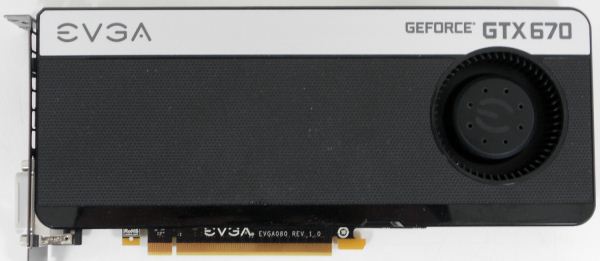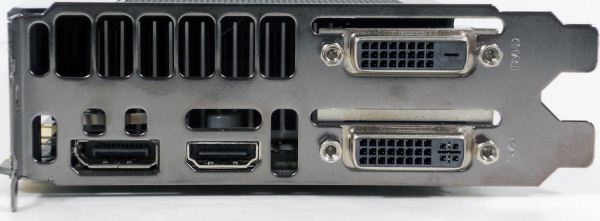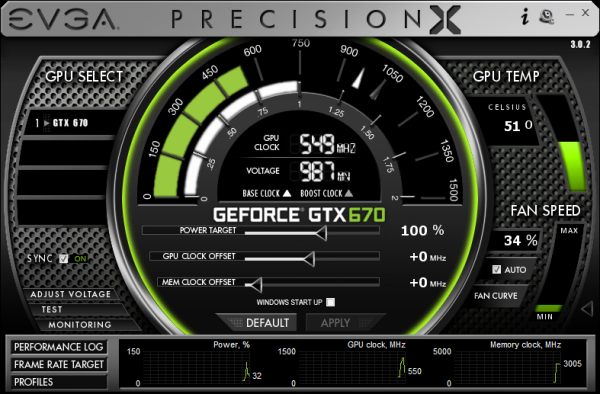NVIDIA GeForce GTX 670 Review Feat. EVGA: Bringing GK104 Down To $400
by Ryan Smith on May 10, 2012 9:00 AM ESTMeet The EVGA GeForce GTX 670 Superclocked
Our second card of the day is EVGA’s GeForce GTX 670 Superclocked, which in EVGA’s hierarchy is their first tier of factory overclocked cards. EVGA is binning GTX 670s and in turn promoting some of them to this tier, which means the GTX 670 Superclocked are equipped with generally better performing chips than the average reference card.
| GeForce GTX 670 Partner Card Specification Comparison | ||||
| EVGA GeForce GTX 670 Superclocked | GeForce GTX 670 (Ref) | |||
| CUDA Cores | 1344 | 1344 | ||
| Texture Units | 112 | 112 | ||
| ROPs | 32 | 32 | ||
| Base Clock | 967MHz | 915MHz | ||
| Boost Clock | 1046MHz | 980MHz | ||
| Memory Clock | 6210MHz | 6008MHz | ||
| Memory Bus Width | 256-bit | 256-bit | ||
| Frame Buffer | 2GB | 2GB | ||
| TDP | 170W | 170W | ||
| Manufacturing Process | TSMC 28nm | TSMC 28nm | ||
| Width | Double Slot | Double Slot | ||
| Length | 9.5" | 9.5" | ||
| Warranty | 3 Years | N/A | ||
| Price Point | $419 | $399 | ||
For the GTX 670 SC, EVGA has given both the core clock and memory clock a moderate boost. The core clock has been increased by 52MHz (6%) to 967MHz base and 66MHz (7%) boost to 1046MHz. Meanwhile the memory clock has been increased by 202MHz (3%) to 6210MHz.
Other than the clockspeed changes, the GTX 670 SC is an almost-reference card utilizing a reference PCB with a slightly modified cooler. EVGA is fabricating their own shroud, but they’ve copied NVIDIA’s reference shroud down to almost the last detail. The only functional difference is that the diameter of the fan intake is about 5mm less, otherwise the only difference is that EVGA has detailed it differently than NVIDIA and used some rounded corners in place of square corners.
The only other change you’ll notice is that EVGA is using their own high flow bracket in place of NVIDIA’s bracket. The high flow bracket cuts away as much metal as possible, maximizing the area of the vents. Though based on our power and temperature readings, this doesn’t seem to have notably impacted the GTX 670 SC.
While we’re on the matter of customized cards and factory overclocks, it’s worth reiterating NVIDIA’s position on factory overclocked cards. Reference and semi-custom cards (that is, cards using the reference PCB) must adhere to NVIDIA’s power target limits. For GTX 670 this is a 141W power target, with a maximum power target of 122% (170W). Fully custom cards with better power delivery circuitry can go higher, but not semi-custom cards. As a result the flexibility in building semi-custom cards comes down to binning. EVGA can bin better chips and use them in cards such as the Superclocked – such as our sample which can go 17 boost bins over the base clock versus 13 bins for our reference GTX 670 – but at the end of the day for stock performance they’re at the mercy of what can be accomplished within 141W/170W.
In any case, as the card is otherwise a reference GTX 670 EVGA is relying on the combination of their factory overclock, their toolset, and their strong reputation for support to carry the card. EVGA has priced the card at $419, $20 over the GTX 670 MSRP, in-line with other factory overclocked cards.
On the subject of pricing and warranties, since this is the first EVGA card we’ve reviewed since April 1st, this is a good time to go over the recent warranty changes EVGA has made.
Starting April 1st, EVGA has implemented what they’re calling their new Global Warranty Policy. Starting July 1st, 2011 (the policy is being backdated), all new EVGA cards ship with at least a 3 year warranty. And for the GTX 600 series specifically, so far EVGA has only offered models with a 3 year warranty in North America, which simplifies their product lineup.
To complement the 3 year warranty and replace the lack of longer term warranties, EVGA is now directly selling 2 and 7 year warranty extensions, for a total of 5 and 10 years respectively. So instead of buying a card with a 3 year warranty or a longer warranty, you’ll simply buy the 3 year card and then buy a warranty extension to go with it. However the extended warranty requires that the card be registered and the warranty purchased within 30 days.
The second change is that the base 3 year warranty no longer requires product registration. EVGA has other ways to entice buyers into registering, but they’ll now honor all applicable cards for 3 years regardless of the registration status. At the same time the base 3 year warranty is now a per-product warranty (e.g. a transferable warranty) rather than per-user warranty, so the base warranty will transfer to 2nd hand buyers. The extended warranties however will not.
The third change is how EVGA is actually going to handle the warranty process. First and foremost, EVGA is now allowing cards to be sent to the nearest EVGA RMA office rather than the office for the region the card was purchased from. For example a buyer moving from Europe to North America can send the card to EVGA’s North American offices rather than sending it overseas.
Finally, EVGA is now doing free cross shipping, alongside their existing Advanced RMA program. EVGA will now cross-ship replacement cards for free to buyers. The buyer meanwhile is responsible for paying to ship the faulty card back and putting up collateral on the new card until EVGA receives the old card.
There’s also one quick change to the step-up program that will impact some customers. With the move to purchasing extended warranties, the step-up program is only available to customers who either purchase an extended warranty or purchase an older generation card that comes with a lifetime warranty. Step-up is not available to cards with only the base 3 year warranty.
Moving on, along with EVGA’s new warranty EVGA is bundling the latest version of their GPU utilities, Precision X and OC Scanner X.
Precision X, as we touched upon quickly in our GTX 680 review, is the latest iteration of EVGA’s Precision overclocking & monitoring utility. It’s still based on RivaTuner and along with adding support for the GTX 600 series features (power targets, framerate caps, etc), it also introduces a new UI. Functionality wise it’s still at the top of the pack along with the similarly RivaTuner powered MSI Afterburner. Personally I’m not a fan of the new UI – circular UIs and sliders aren’t particularly easy to read – but it gets the job done.
OC Scanner X has also received a facelift and functionality upgrade of its own. Along with its basic FurMark-ish stress testing and error checking, it now also offers a basic CPU stress test and GPU benchmark.



















414 Comments
View All Comments
CeriseCogburn - Sunday, May 13, 2012 - link
This is your false claim about obviously. It's your and Charlie D's semi-accurate hit piece opinion and nothing else.dagamer34 - Thursday, May 10, 2012 - link
Products actually have to be consistently available for significant price drops like what you want to happen. Right now, if you need a high end card TODAY, waiting around for a GTX 680 isn't really an option, you'll have to go for the 7970 and AMD knows that.CeriseCogburn - Thursday, May 10, 2012 - link
Nope, 670 is all over the egg. Sorry you're late with that crap, and it's USA only BTW concerning 680 - the rest of the non obama world isn't suffering and can you really blame the asain(China/ commie cap government) manufacturers ?anubis44 - Friday, May 11, 2012 - link
"In the end they can't keep GK104 in stock anywhere and they still manage to beat AMD convincingly in both price and performance."You mean nvidia can't seem to make any. According to this article, nvidia has only been able to make a fraction of the GK104s that AMD has made Tahitis:
http://semiaccurate.com/2012/05/08/nvidias-five-ne...
That's what happens when you don't understand the manufacturing process you're moving to. You design a chip that's so ambitious, the failure rate is spectacular. AMD (and ATI before) on the other hand are much more familiar with the limits of successive process technology at TSMC, hence they are getting higher yields per wafer despite having a slightly larger die size, even without neutering their GPGPU compute circuitry like nvidia did.
eddman - Friday, May 11, 2012 - link
I wouldn't put too much weight in charlie's opinionated so called articles.CeriseCogburn - Friday, May 11, 2012 - link
If you read them on nVidia, and it is painful to see the twisted incoherent lies and completely contradictory links that disprove his stated reason for posting them or simply do not contain what he claimed they do, any bit of weight is too much weight at all.It's an amd fanboy firestarter flamer site, charlie's biggest purchase is red tipped matches and gasoline in a red can.
chizow - Sunday, May 13, 2012 - link
Can't agree with this for a lot of reasons. Maybe in the past with the huge GPU dies, but GK104 is *SMALLER* than Tahiti so there's really nothing ambitious about it.For capacities, Nvidia and TSMC have very close relationships and we know for a fact Nvidia is selling 2 GPUs for every 1 of AMDs, so Nvidia has an advantage there in terms of orders placed as well.
There's no reason to believe Nvidia is at any process disadvantage relative to AMD on 28nm, if anything everyone is supply constrained as other players try to move in (like Apple).
The fact there's plenty of GTX 670s still available after 3 days after launch with EXTREMELY favorable reviews tells me supply is excellent, and that Nvidia is only supply constrained on the high-end with perfect ASICs splitting good die between GTX 680 and 690.
chizow - Thursday, May 10, 2012 - link
Per usual Ryan, very relevant observations and interesting insight in regard to the changes Nvidia has made.I think I would take some of your first page insights a bit further:
1) GTX 680 is probably already heavily "overclocked" and binned to achieve a SKU Nvidia may not have planned originally, in order to beat the 7970 with a mid-range ASIC.
2) We will probably see an even more heavily harvested GK104 chip soon, given how little GTX 670 cuts from GTX 680 (just 1 SMX), but Nvidia can't cut too much without significantly impacting performance.
3) Pricing as you've laid out nicely, is probably $50-$100 too high across the board for all of these 28nm parts somewhere in the +20-25% premium range based on relative performance and historical pricing.
There's quite a few minor grammar errors throughout your article, nothing a quick proofread won't correct, but the content is excellent as usual.
Iketh - Thursday, May 10, 2012 - link
will you take the words "historical pricing" and remove them from your vocabulary? PLEASE?chizow - Thursday, May 10, 2012 - link
Its obvious the term is completely foreign to many here, including yourself, so until its well understood what it means and why its important and relevant to the discussion, I'll continue to use it."Those who do not learn from their mistakes are doomed to repeat them".
You're not even in a position to learn from your mistakes when you don't even understand the importance of "historical pricing".